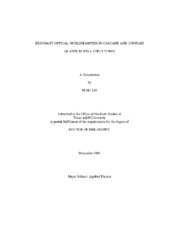| dc.description.abstract | Resonant or near resonant optical nonlinearities in semiconductor coupled
quantum-well systems are discussed. Quantum engineered coupled or cascade quantumwell
structures can provide giant nonlinear susceptibilities for various optical nonlinear
processes. Nonlinearities integrated within quantum cascade lasers (QCL) showed great
potential in various applications in the infrared range. Several schemes of nonlinearities
are proposed and discussed in this work.
Integrating difference frequency generation (DFG) with QCL can yield long
wavelength radiation, such as terahertz light. The DFG process does not require
population inversion at a transition associated with low photon energy; however, this
requirement is necessary to lasers, such as QCL, and is hard to meet, because of the
thermal backfilling and inefficient injection or pumping at room temperature. Therefore
terahertz radiation due to DFG QCL for room temperature is proposed. On the other
hand, the second harmonic generation can double laser frequency, and then push
radiation frequency of AlInAs/GaInAs/InP based QCL to short wavelengths such as 3
μm and shorter. Optical nonlinearities can extend working frequencies of light sources, and also
can help to improve light detection. For example, a sum frequency generation can upconvert
mid/far-IR signal into near-IR signal with strong near-IR pump light, namely
high efficient near-IR photon detector could be employed to detect mid/far-IR light. A
specific designed quantum well structure of this frequency up-conversion scheme is
discussed.
A scheme of monolithic in-plane integration of the optical nonlinearities with
QCL is also proposed. In this scheme, an optical nonlinear section is made from the
same quantum well structure of a QCL, and is under an independent applied bias. Due to
the independence of the applied bias, the nonlinearities can be tuned flexibly. In
particular, a widely tunable Raman laser based on this scheme could be achieved.
A frequency up-conversion based on sum frequency generation process in
coupled quantum-well structure is also proposed for mid-infrared detection. By
converting mid-IR signal to near-IR, superior near-IR detector such as silicon avalanche
photo diode (APD) can be employed. The scheme can provide lower noise equivalent
power (NEP) or higher detectivity compared with regular semiconductor photo detectors.
A scheme of lasing without inversion (LWI) based on QCL for THz radiation is
proposed. A ladder type three-level system for LWI process is integrated into a boundto-
continue high power QCL at 10 μm. The proposed LWI generates THz signal at 69
μm. An optical gain about 80 cm-1 is achieved, against a waveguide loss about 30 cm-1 in
a semi insulator (SI) surface plasmon waveguide. | en |


